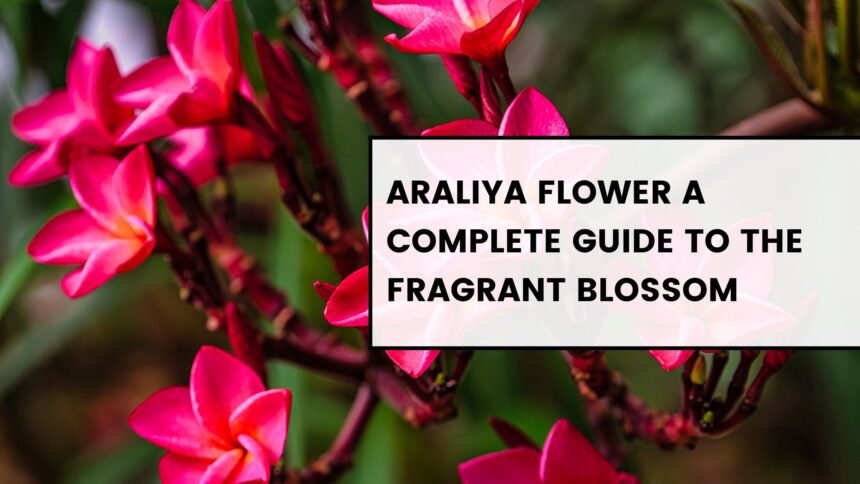The Araliya flower, also known as the Frangipani (scientific name: Plumeria), is a tropical blossom treasured for its beauty and fragrance. Known for its waxy petals and striking white and yellow hues, this flower is a symbol of peace, immortality, and beauty in many cultures. In this guide, we’ll explore everything you need to know about the Araliya flower, from its history to growing tips, and why it’s a favorite among gardeners and nature lovers.
What is the Araliya Flower?
The Araliya flower is native to the Caribbean, Central America, and South America, though it has become synonymous with tropical regions worldwide. It thrives in warm, sunny climates and is commonly found in places like Hawaii, Southeast Asia, and the Pacific Islands.
One of the primary reasons the Araliya flower is cherished is its delightful fragrance, which becomes more pronounced in the evening. The plant is also recognized for its drought resistance and adaptability, making it a low-maintenance choice for gardeners.
Types of Araliya Flowers
There are several varieties of Araliya flowers, each unique in color and shape. Here’s a quick overview:
| Type | Description |
|---|---|
| Plumeria rubra | Known for its vibrant red or pink flowers, often with a sweet scent. |
| Plumeria alba | Features white flowers with yellow centers; popular in tropical regions. |
| Plumeria obtusa | Recognized for its round petals and strong fragrance. |
| Plumeria stenopetala | A rarer species, known for its narrow petals and pale yellow hue. |
These varieties are often used in landscaping, leis, and floral decorations due to their striking appearance and intoxicating aroma.
How to Grow Araliya Flowers
Growing Araliya flowers at home is easier than you might think. Follow these steps for success:
Step 1: Choose the Right Location
Araliya thrives in sunny spots. Select a location that gets 6-8 hours of sunlight daily. It’s important for the plant to have well-drained soil to prevent root rot.
Step 2: Planting
- Propagation: Araliya flowers can be grown from seeds or cuttings. Cuttings are preferred for faster results.
- Planting Depth: If you’re planting a cutting, ensure that at least 2 inches of the stem is buried in the soil.
Step 3: Watering
Araliya plants are drought-tolerant but require regular watering during the growing season. Water deeply but infrequently, allowing the soil to dry between sessions.
Care and Maintenance Tips
Maintaining your Araliya plant doesn’t require too much effort. Here are some care tips to keep your plant thriving:
- Fertilization: Use a high-phosphorus fertilizer during the blooming season to encourage flower production.
- Pruning: Regular pruning helps in maintaining the plant’s shape and encourages new growth.
- Pest Control: The Araliya flower is generally resistant to pests, but you may occasionally notice aphids or whiteflies. Treat with neem oil or a gentle insecticidal soap.
Cultural Significance of the Araliya Flower
In many parts of the world, the Araliya flower holds deep cultural and spiritual significance:
- Hawaii: Used in leis to symbolize welcome and friendship.
- Sri Lanka: Often found in Buddhist temples and is associated with purity.
- Polynesia: Worn by women to indicate their relationship status—on the right ear if single and the left ear if taken.
The flower’s symbolism of peace, purity, and spirituality makes it a popular choice for rituals and ceremonies.
Common FAQs About Araliya Flowers
How long does it take for an Araliya plant to bloom?
It typically takes 1-3 years for an Araliya plant to bloom when grown from a cutting, but plants grown from seeds may take longer, around 3-5 years.
Can Araliya flowers grow indoors?
Yes, Araliya can be grown indoors, but it needs plenty of sunlight. Ensure you place it in a bright spot, like near a window, and use well-draining soil.
Are Araliya flowers toxic to pets?
Yes, the sap from Araliya plants can be toxic to pets if ingested. Keep pets away from the plant or supervise them in the garden.
What’s the best way to propagate Araliya?
Cuttings are the easiest and most reliable method. Take a cutting from a mature plant, let it dry for a day or two, then plant it in well-draining soil.
Why are my Araliya leaves turning yellow?
Yellow leaves can indicate overwatering or poor drainage. Ensure the plant’s soil is well-drained and reduce watering if necessary.
Conclusion
The Araliya flower is a stunning, fragrant, and easy-to-care-for plant that can add a tropical flair to any garden. Whether you’re interested in its cultural significance or simply want to enjoy its beauty, the Araliya flower is a rewarding addition to your plant collection.
Call to Action:
Interested in growing your own Araliya flower? Check out our detailed guide on plant care and propagation techniques and start cultivating this tropical beauty today!

